Emails announcing price drops are vital in any comprehensive email marketing strategy. Beyond catering to consumers’ desire for sales, these emails facilitate the swift turnover of new products, preventing them from becoming outdated on the shelves.
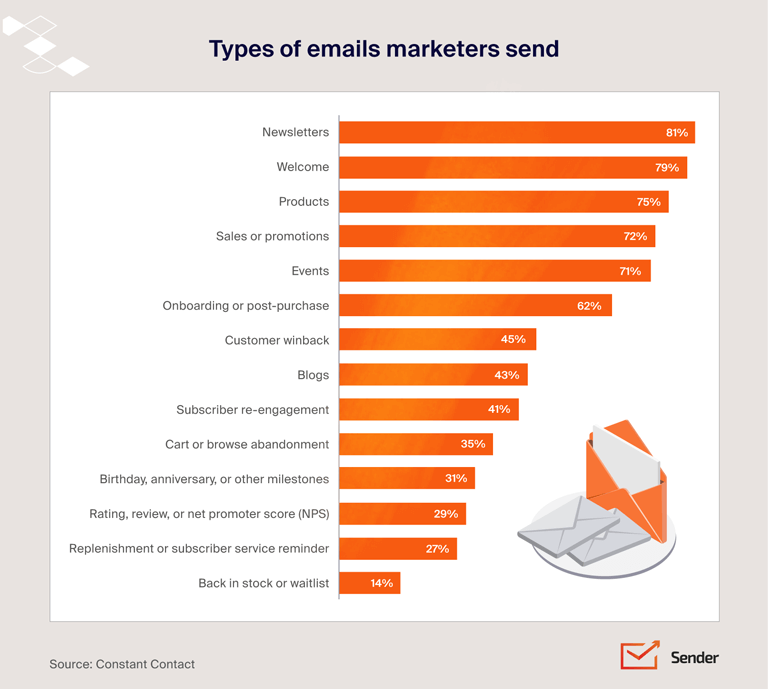
Given various brands’ widespread emphasis on price drops, it becomes imperative to delve into key considerations before implementation. Essential questions to address include:
- Optimal Utilization of Price Drop Emails: Understanding the most effective ways to deploy price drop emails is crucial. This involves exploring strategies that resonate well with the target audience and yield positive results.
- Industry-Specific Tactics: Different industries may require tailored approaches to price drop emails. Identifying tactics that align with the unique characteristics and preferences of specific sectors can significantly enhance the impact of these emails.
- Strategic Language and Approaches: Employing the right words and strategies is essential in crafting compelling price drop emails. A strategic choice of language can positively influence customer perception and engagement.
What is a Price Drop Email?
A Price Drop Email is a strategic email marketing approach businesses employ to communicate to their audience about reduced prices on specific products, often best-sellers or favorites. The primary goal is to alert subscribers to recent price decreases, encouraging them to make purchases and save money.
These emails are a direct channel to inform subscribers about ongoing discounts, creating a sense of urgency and an opportunity for customers to benefit financially. While widely recognized as a valuable tactic during holiday seasons like Black Friday and Cyber Monday, Price Drop Emails are effective throughout the year.
Examples of Effective Price Drop Emails:
1. GoPro:

The featured Price Drop Email from GoPro promotes the HERO8 Black camera, emphasizing its “new low price.” Designed with a captivating dark background, the email strategically showcases an image of the HERO8 Black product. This approach aims to engage the recipient visually and create a compelling impact.
The email is strategically tailored for nonimpulsive buyers, particularly camera enthusiasts who prioritize thorough research before purchasing. Recognizing the target audience’s meticulous approach, the email refrains from explicitly stating the discount amount. Instead, it employs a savvy tactic of focusing on the camera’s key features.
The email concisely describes the HERO8 Black’s essential features, acknowledging that potential buyers, especially experts, consider these aspects critically. By stating that “8 is the one,” the email suggests the superiority of the HERO8 Black and implies that it meets the specific needs of camera enthusiasts.
Crucially, the email then communicates that the price has been lowered. The deliberate omission of the exact discount amount does not diminish the effectiveness of the message. Instead, it adds an element of curiosity and entices potential buyers to explore further, creating a sense of intrigue and encouraging them to take prompt action.
2. Honey:
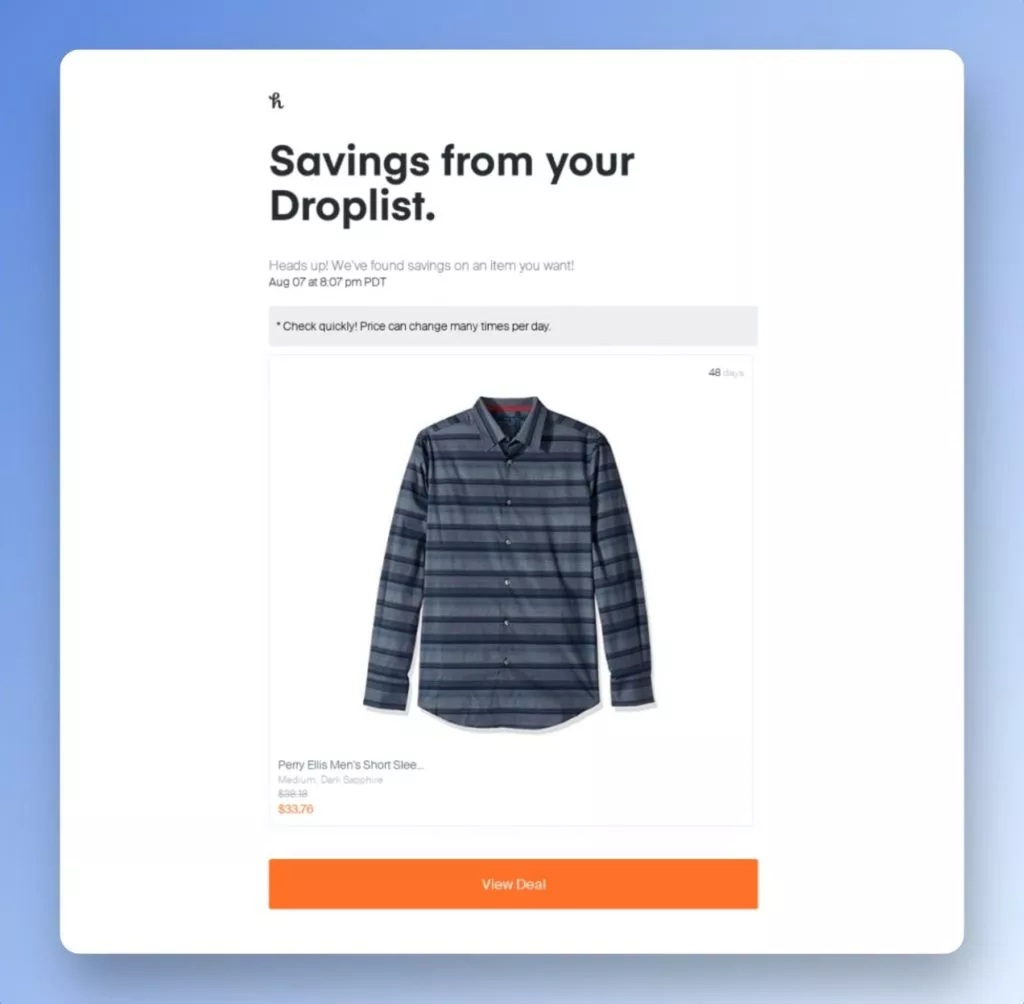
The Price Drop Email example from PayPal Honey, formerly known as Honey, represents an innovative approach to personalized marketing through email. Honey, an American technology company under the PayPal umbrella, specializes in a browser extension that automates the application of online coupons, centralizing its business around price drops and discounts.
The subject line, “Saving From Your Droplist,” immediately communicates the email’s content, providing a clear expectation for the recipient. Honey’s use of personalization becomes apparent as It tailors the offer based on the user’s search history, aligning with items they have previously shown interest in.
The email features a long-sleeve shirt on sale and a vibrant orange call-to-action button prompting the recipient to “view the deal.” This eye-catching button is a direct and enticing gateway for users to explore the discounted product quickly.
The message “Check quickly! Price can change many times per day” introduces urgency, leveraging the Fear of Missing Out to encourage immediate action. By emphasizing the potential volatility of prices, Honey capitalizes on the psychological triggers that drive swift decision-making.
3. Jomashop:
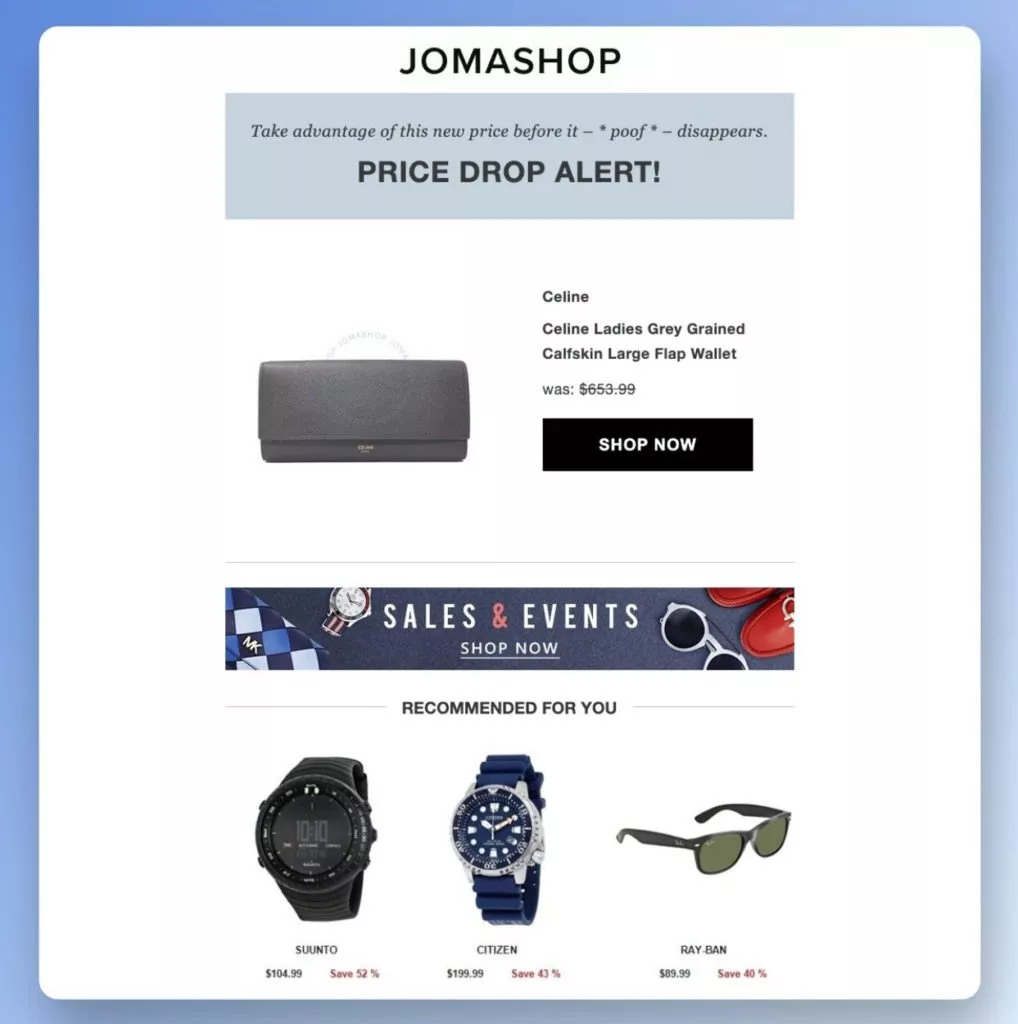
Jomashop, a prominent “grey market” dealer specializing in offloaded stock from authorized dealers, showcases an effective Price Drop Email strategy. Due to its unique business model, Jomashop is not obligated to adhere to full retail prices, making its price drop emails particularly enticing.
The subject line, “Drop Price Alert,” immediately grabs the recipient’s attention, hinting at the potential savings within the email. This email presents a discounted price for a high-value item and incorporates personalized product recommendations. Leveraging the user’s shopping history and preferences, Jomashop enhances the relevance of its offerings.
A well-designed layout featuring the Celine Ladies Grey Grained product with a discounted price serves as the centerpiece. Notably, the email doesn’t just focus on the discounted item; it integrates additional product recommendations at the footer, creating a comprehensive shopping experience.
By aligning the product recommendations with the recipient’s preferences, Jomashop ensures that the email provides substantial value, combining a discount offer with relevant suggestions. This approach maximizes the potential for reader engagement and prompts users to consider multiple purchases.
4. Pink Blush:
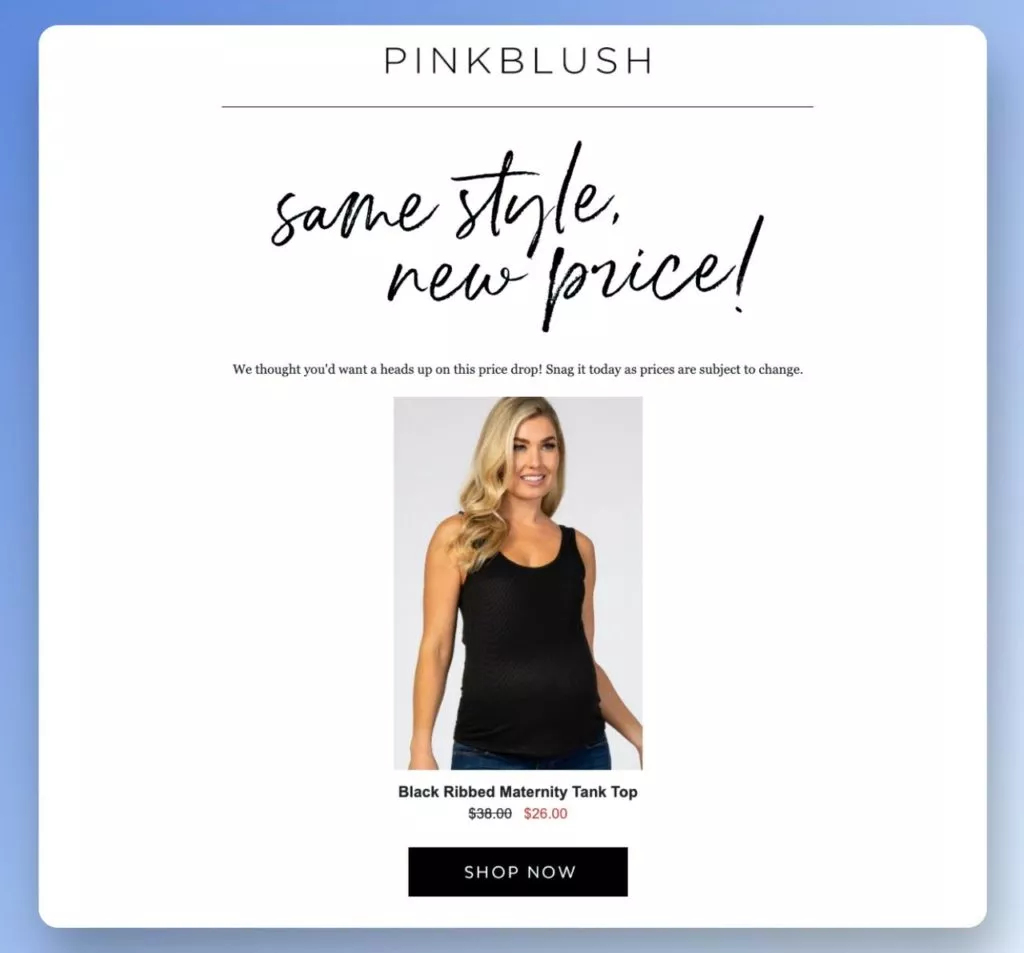
Pink Blush employs a user-specific discount strategy in its Price Drop Email, emphasizing transparency and exclusivity. The email communicates the exact amount the product’s price has dropped, fostering a sense of openness and honesty.
The email’s introductory sentence, “We thought you’d want a heads up on this price drop,” adds a personalized touch, making the recipient feel privileged to receive exclusive information. This subtle approach establishes a connection with the user, enhancing the perceived value of the discount.
To further induce a sense of urgency and encourage immediate action, Pink Blush strategically introduces the element of time sensitivity, stating that the offer may end soon. This tactic plays on Fear of Missing Out (FOMO) and motivates users to capitalize on the opportunity promptly.
Taking user engagement a step further, Pink Blush concludes the email with a product recommendation section titled “Love That? You’ll love these.” By showcasing additional relevant products, the brand extends the scope of user interest and encourages a more extensive shopping experience.
Learn about free trial emails here.
5. UpWest:
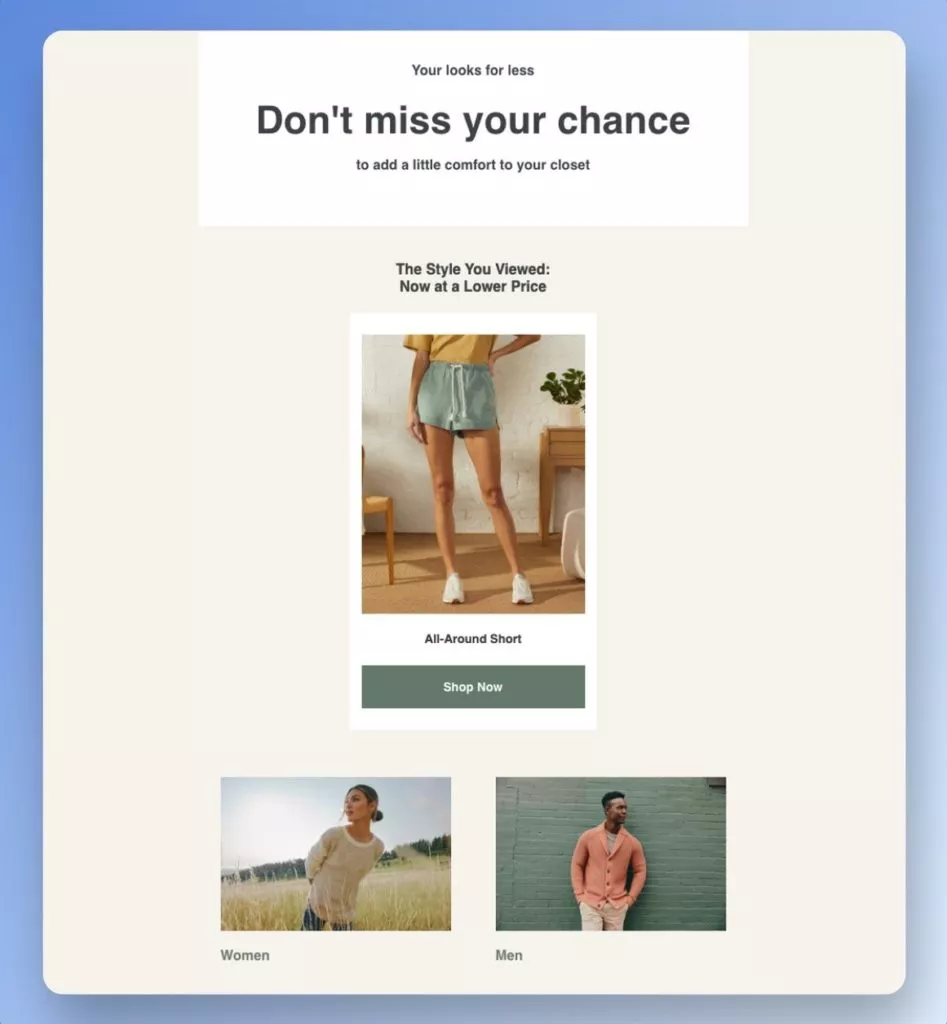
UpWest employs a language-driven approach in its Price Drop Email, leveraging trigger words to evoke emotions and prompt immediate action. Phrases like “Don’t Miss Your Chance” and “Shop Now” create a sense of urgency, compelling readers to take immediate action.
The strategic use of trigger words, including “Last Chance,” “Limited Offer,” and “Exclusive Price Drop,” communicates to the reader that a unique opportunity is at hand. By instilling a fear of missing out and emphasizing exclusivity, UpWest taps into powerful psychological triggers.
The email design features a title, “Don’t miss your chance,” and an enticing image of the “all-around short” product. The “Shop Now” call-to-action is strategically placed, driving users to explore the discounted product swiftly.
While leveraging fear as an emotion can be potent, UpWest balances this approach by emphasizing exclusivity. This combination creates a compelling narrative, enticing readers to seize the opportunity promptly.
The discussion includes an essential reminder to caution against using trigger words. Authenticity in delivering the promised value is crucial for sustained customer trust.
6. WikiBuy:
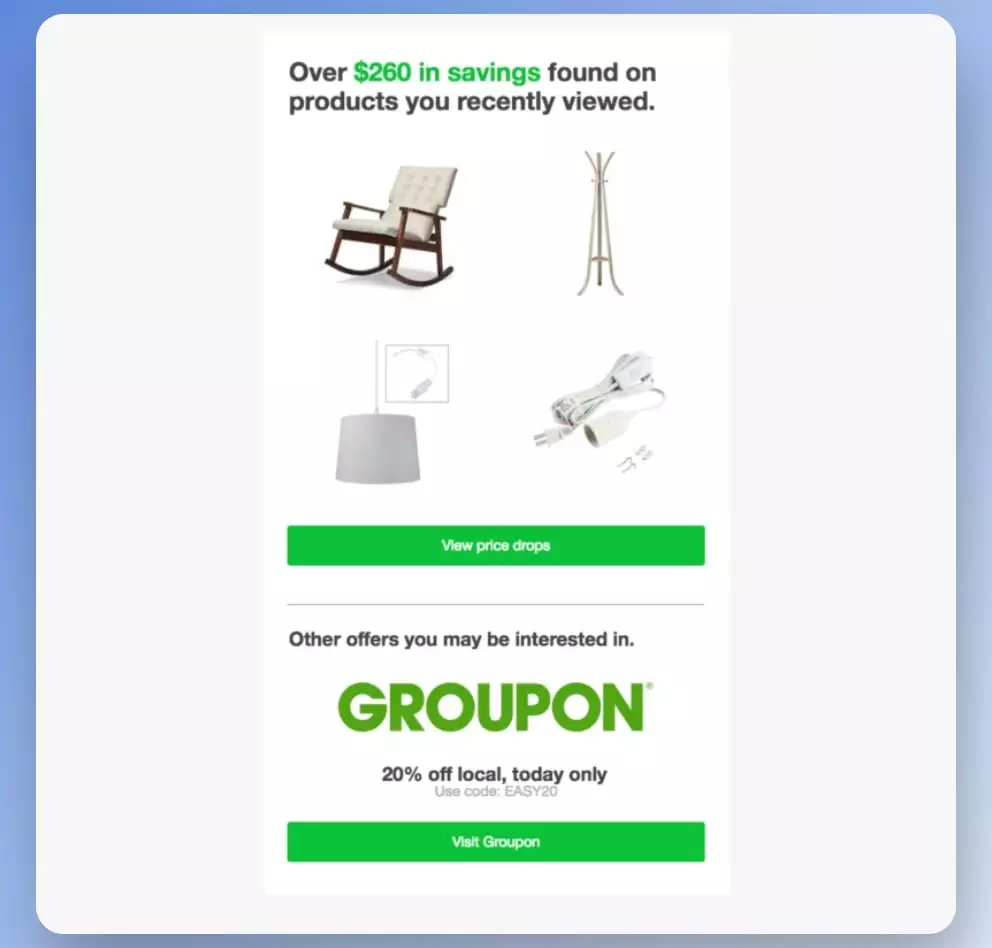
WikiBuy employs a highly effective strategy of sending daily price drop emails to consistently update users on the latest discounts, positioning itself as a reliable source for real-time savings. Like the Honey platform, WikiBuy meticulously tracks user purchases and successful coupon usage, leveraging this data to offer precise and tailored information to its diverse customer base.
The significance of daily price drops in WikiBuy’s approach lies in its commitment to delivering optimal deals to users. WikiBuy ensures users can explore new, budget-friendly deals regularly by providing a daily influx of updated discounts. This approach aligns with WikiBuy’s mission to empower users with accurate and timely information, fostering a dynamic and engaging shopping experience.
The email design features a selection of home furnishings, such as lamps and chairs, with attractive discounted offers. This visual representation enhances the products’ appeal and communicates the tangible savings users can enjoy. The emphasis on a daily cadence encourages users to check WikiBuy regularly, creating a habit of seeking out deals that match their budget and preferences.
7. Target:
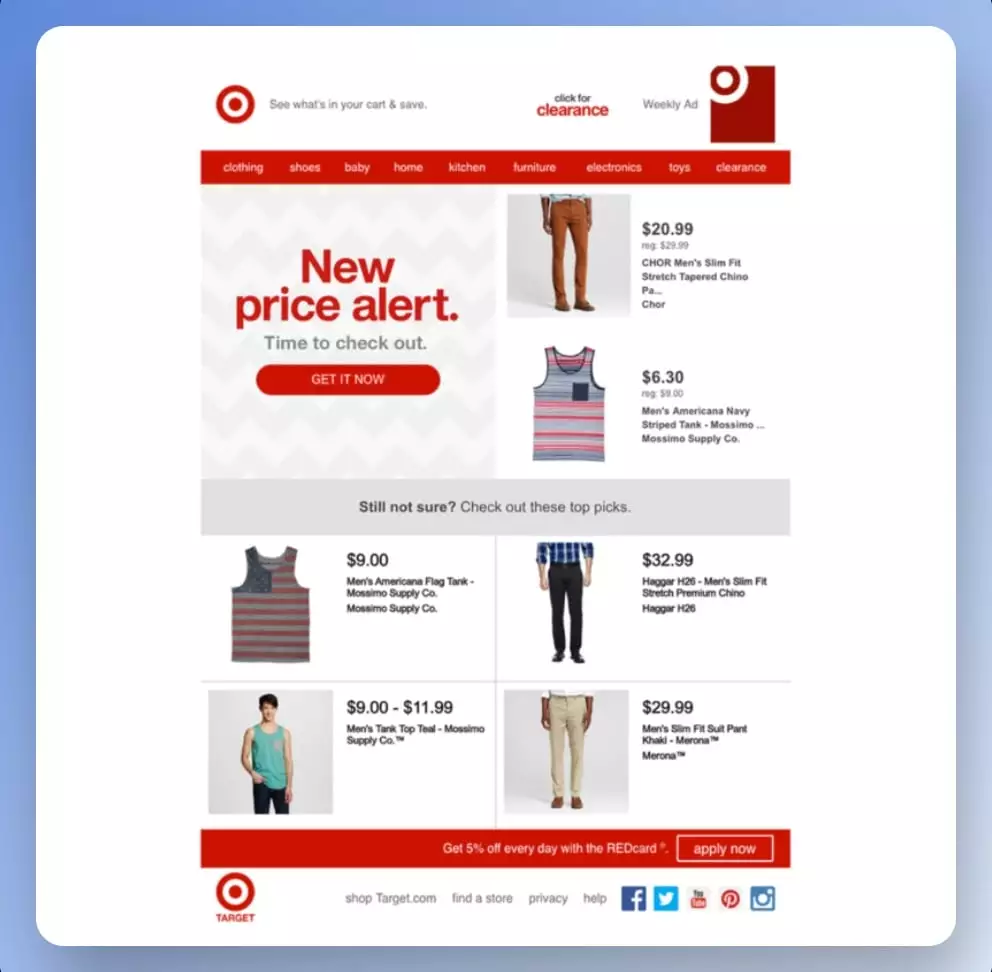
Target strategically employs price drop emails to promote and clear out old stock and seasonal items. The objective is to present users with enticing deals on products that are on their way out, creating a sense of urgency and opportunity.
The email’s title, “New Price Alert,” sets the tone for the announcement of discounted items featuring various products like tops, shirts, and pants. Notably, the email strategically positions the cheapest items at the top, leveraging the psychological appeal of affordability to capture users’ attention.
Including a $6.30 item is a compelling motivator for users, tapping into the impulse to purchase an item simply due to its extremely affordable price. This tactic aligns with Target’s goal of efficiently moving old stock by making the deals irresistible to potential buyers.
8. Academy:
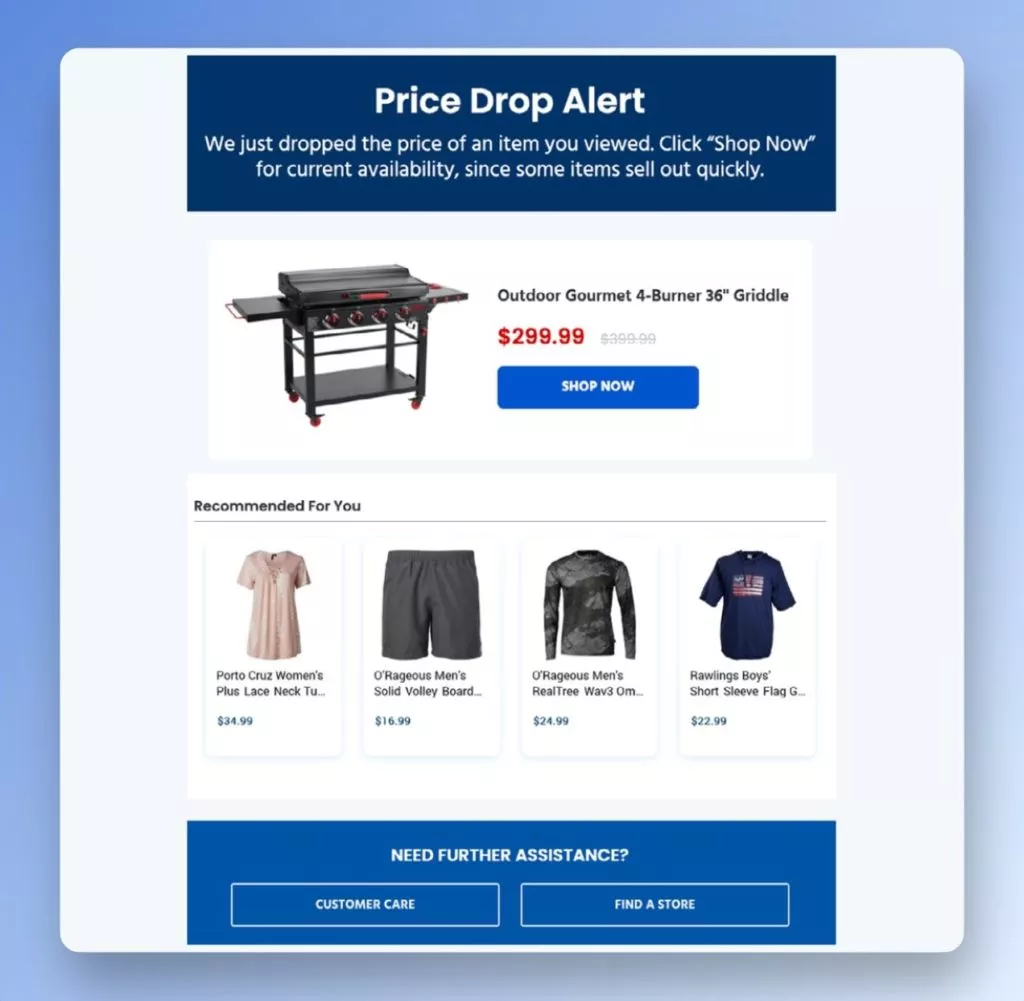
Academy adopts a thoughtful approach in its price-drop email strategy, recognizing the importance of not overwhelming recipients with an abundance of options. The brand acknowledges the psychological concept of over choice, where presenting too many options can lead to decision fatigue, negatively impacting the user’s purchasing decision.
The email features a discounted product, the Outdoor Gourmet 4-Burner 36″ Griddle, with an almost $100 discount. Academy strategically avoids inundating the recipient with a multitude of discounted offers, emphasizing quality over quantity.
The brand’s understanding of the potential pitfalls of over choice reflects a commitment to enhancing the user experience. Studies indicate that brands that streamline the purchase decision journey are more likely to be recommended and repurchased. Academy’s approach aligns with this insight, ensuring that users can make decisions more comfortably without being overwhelmed by excessive choices.
Conclusion:
If you’re seeking guidance on launching a successful price drop email campaign, the examples provided above serve as an excellent starting point. Statistics indicate that a compelling value exchange (incentive) can prompt up to 90% of users to willingly share their data. To establish trust and prioritize data privacy concerns, adopt a consumer-centric approach, emphasizing transparency and clarity in your communication.
Your discount offer can take various forms, such as a percentage off, a fixed monetary reduction, or a combination of both. The key is to articulate the terms of the price drop clearly, both within the email and on the corresponding product page. This ensures transparency and prevents any ambiguity that might deter potential customers.
These examples aim to inspire and equip you with effective strategies for your next price-drop email marketing campaign. By leveraging converting popups and employing a consumer-friendly approach, you can not only enhance your email list but also fuel your marketing endeavors more accurately. Consider using user-friendly tools like Popupsmart, a simple popup builder, to effortlessly customize templates that align with your brand voice and identity.
FAQs on Price Drop Emails:
How often do retailers send price drop emails?
The frequency of price drop emails varies among retailers. Some may send them regularly, while others send them selectively based on specific promotions or changes in product prices.
Do price drop emails expire?
The validity of a price drop email depends on the retailer’s policy. Some may have a limited-time offer, while others may not specify an expiration date.
Are price drop emails secure?
Price drop emails from reputable retailers are generally secure. However, it’s essential to be cautious of phishing attempts and only interact with emails from trusted sources.



